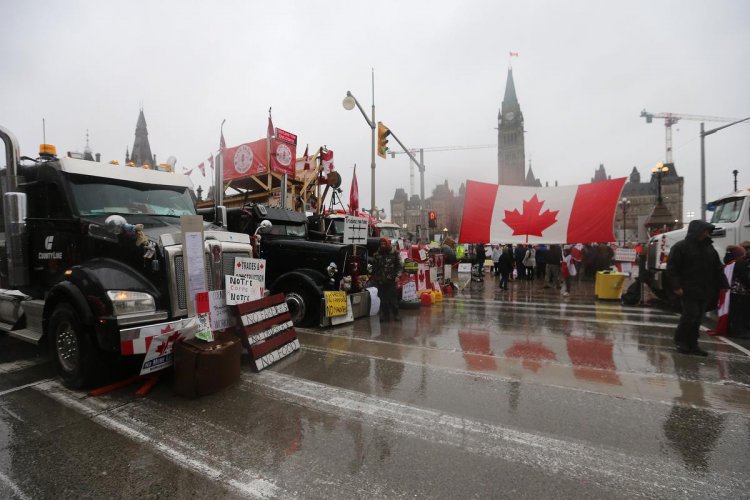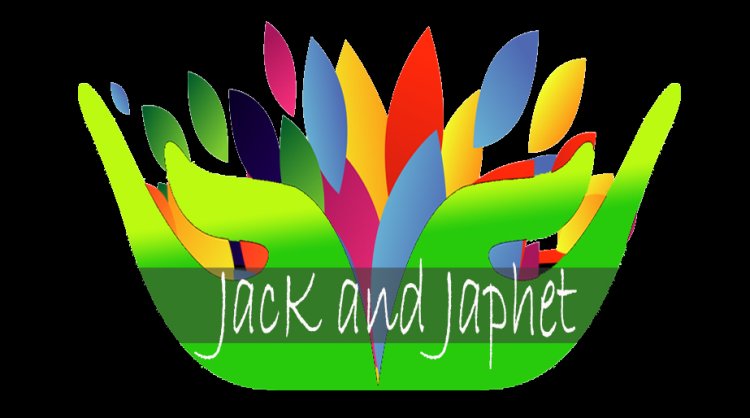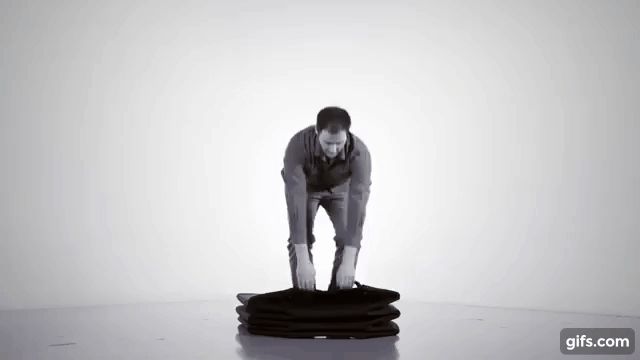Stronger police presence in Ottawa as officers prepare to end trucker protest
OTTAWA—More security fences were erected around Parliament as a historic debate on what the Trudeau government says is a national emergency was underway Thursday.On Wellington Street there was visibly a stronger police presence as more officers got in place on a rainy morning. After police warned of pending action in the hours and days ahead, protesters showed no signs of movement, continuing to play music and cook food on Wellington Street. Others held up signs asking police to remove barriers in respect of their Charter rights. Police vehicles were gathering at sites away from Parliament Hill in the city, and the Sûreté du Québec said it was arriving to assist a beleaguered Ottawa city police service to end the occupation of the city’s downtown core.On Wednesday night, convoy organizer Tamara Lich released a tearful video suggesting she might soon be removed from the demonstration.“I think it’s inevitable at this point, but I’ll probably be going somewhere tomorrow where I’ll be getting three square meals a day. And that’s okay. I’m okay with that. And I want you to know that I am not afraid,” she told supporters.The Liberal government released a package of documents late Wednesday night that outlined for the Commons debate its reasons for declaring a public order emergency.“The situation across the country remains concerning, volatile and unpredictable,” it said.For the first time, the Liberal government said “threats were also made to block railway lines, which would result in significant disruptions” to trade corridors that carry $310 billion in goods each year.While border blockades had been cleared and traffic had resumed at Coutts, Alberta, and Emerson, Manitoba, the Liberal government signalled the overall threat has not ended.“The protests have become a rallying point for anti-government and anti-authority, anti-vaccination, conspiracy theory and white supremacist groups throughout Canada and other Western countries. The protesters have varying ideological grievances, with demands ranging from an end to all public health restrictions to the overthrow of the elected government,” the documents said.Describing the chaos in Ottawa, it cited the resignation of Ottawa Police chief Peter Sloly “in response to criticism of the police’s response to the protests.”Several premiers opposed the use of the Emergencies Act on their territory, including Alberta, Saskatchewan, Manitoba and Quebec. Others like Ontario and Newfoundland and Labrador supported the Trudeau government’s response.But the Trudeau government insisted the new powers aren’t meant to supplant local police decisions, but to enhance their authorities.Prime Minister Justin Trudeau emphasized in his speech to the Commons Thursday morning the powers are “time limited” and targeted at regions where needed.Trudeau warned there is a strong foreign influence on the protest, and painted the convoys that have spread as a threat to the Canadian economy and democracy. The Opposition Conservatives and Bloc Quebecois are dead set against it, while the minority government has the support of the New Democrats.NDP leader Jagmeet Singh underlined the convoy organizer’s goal of overthrowing the government.Conservative interim leader Candice Bergen said historically the Canadian government has only invoked emergency powers in the two world wars and the FLQ crisis, and argued the modern version of the War Measures Act is not needed at this time, calling it “an overreach.”“We believe the trucks should move or be moved,” she said. But the prime minister has done “nothing” to listen to protesters other than “stigmatize, wedged, divided and traumatized Canadians,” has failed to meet with any trucker, or apologize for his divisive rhetoric, Bergen told the Commons.The government’s documents pointed to the hack of crowdfunding website GiveSendGo and a CBC analysis that showed 55 per cent of donations made public were made by donors in the U.S compared to 39 per cent of donors located in Canada.“Ideologically motivated violent extremism adherents may feel empowered by the level of disorder resulting from the protests. Violent online rhetoric, increased threats against public officials and the physical presence of ideological extremists at protests also indicate that there is a risk of serious violence and the potential for lone actor attackers to conduct terrorism attacks.”With files from Raisa Patel, Alex BallingallTonda MacCharles is an Ottawa-based reporter covering federal politics for the Star. Follow her on Twitter: @tondamacc


OTTAWA—More security fences were erected around Parliament as a historic debate on what the Trudeau government says is a national emergency was underway Thursday.
On Wellington Street there was visibly a stronger police presence as more officers got in place on a rainy morning.
After police warned of pending action in the hours and days ahead, protesters showed no signs of movement, continuing to play music and cook food on Wellington Street. Others held up signs asking police to remove barriers in respect of their Charter rights.
Police vehicles were gathering at sites away from Parliament Hill in the city, and the Sûreté du Québec said it was arriving to assist a beleaguered Ottawa city police service to end the occupation of the city’s downtown core.
On Wednesday night, convoy organizer Tamara Lich released a tearful video suggesting she might soon be removed from the demonstration.
“I think it’s inevitable at this point, but I’ll probably be going somewhere tomorrow where I’ll be getting three square meals a day. And that’s okay. I’m okay with that. And I want you to know that I am not afraid,” she told supporters.
The Liberal government released a package of documents late Wednesday night that outlined for the Commons debate its reasons for declaring a public order emergency.
“The situation across the country remains concerning, volatile and unpredictable,” it said.
For the first time, the Liberal government said “threats were also made to block railway lines, which would result in significant disruptions” to trade corridors that carry $310 billion in goods each year.
While border blockades had been cleared and traffic had resumed at Coutts, Alberta, and Emerson, Manitoba, the Liberal government signalled the overall threat has not ended.
“The protests have become a rallying point for anti-government and anti-authority, anti-vaccination, conspiracy theory and white supremacist groups throughout Canada and other Western countries. The protesters have varying ideological grievances, with demands ranging from an end to all public health restrictions to the overthrow of the elected government,” the documents said.
Describing the chaos in Ottawa, it cited the resignation of Ottawa Police chief Peter Sloly “in response to criticism of the police’s response to the protests.”
Several premiers opposed the use of the Emergencies Act on their territory, including Alberta, Saskatchewan, Manitoba and Quebec. Others like Ontario and Newfoundland and Labrador supported the Trudeau government’s response.
But the Trudeau government insisted the new powers aren’t meant to supplant local police decisions, but to enhance their authorities.
Prime Minister Justin Trudeau emphasized in his speech to the Commons Thursday morning the powers are “time limited” and targeted at regions where needed.
Trudeau warned there is a strong foreign influence on the protest, and painted the convoys that have spread as a threat to the Canadian economy and democracy.
The Opposition Conservatives and Bloc Quebecois are dead set against it, while the minority government has the support of the New Democrats.
NDP leader Jagmeet Singh underlined the convoy organizer’s goal of overthrowing the government.
Conservative interim leader Candice Bergen said historically the Canadian government has only invoked emergency powers in the two world wars and the FLQ crisis, and argued the modern version of the War Measures Act is not needed at this time, calling it “an overreach.”
“We believe the trucks should move or be moved,” she said. But the prime minister has done “nothing” to listen to protesters other than “stigmatize, wedged, divided and traumatized Canadians,” has failed to meet with any trucker, or apologize for his divisive rhetoric, Bergen told the Commons.
The government’s documents pointed to the hack of crowdfunding website GiveSendGo and a CBC analysis that showed 55 per cent of donations made public were made by donors in the U.S compared to 39 per cent of donors located in Canada.
“Ideologically motivated violent extremism adherents may feel empowered by the level of disorder resulting from the protests. Violent online rhetoric, increased threats against public officials and the physical presence of ideological extremists at protests also indicate that there is a risk of serious violence and the potential for lone actor attackers to conduct terrorism attacks.”
With files from Raisa Patel, Alex Ballingall
Tonda MacCharles is an Ottawa-based reporter covering federal politics for the Star. Follow her on Twitter: @tondamacc




















